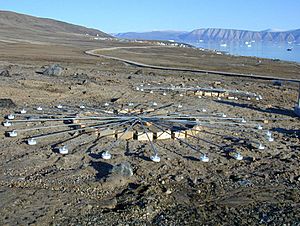Infrasound facts for kids
Infrasound is a special type of sound that has a very low frequency. This means its sound waves vibrate much slower than what human ears can normally hear. The frequency of infrasound is below 16 hertz (Hz). Even though we can't hear it, if the sound is loud enough, we might feel it as vibrations.
Younger people often have better hearing and can sometimes detect slightly lower or higher frequencies than adults. Some animals, like whales and elephants, use infrasound to talk to each other over very long distances. It's like their secret, long-range communication system!
Contents
What is Infrasound?
Sound travels in waves, and the frequency of these waves tells us how high or low a sound is. High-frequency sounds have waves that vibrate quickly, like a whistle. Low-frequency sounds have waves that vibrate slowly, like a deep rumble. Infrasound is at the very bottom of this range, with waves vibrating so slowly that they are beyond our normal hearing ability.
Think of it like a very deep bass note that you can feel in your chest at a concert, even if you can't clearly hear the individual notes. That's a bit like how infrasound works, but even lower.
How Do Humans Experience Infrasound?
Even though we can't hear infrasound, it can still affect us. When infrasound is strong, we might feel it as a pressure or a vibration in our bodies. Some people report feeling uneasy or strange when exposed to strong infrasound, even if they don't know what's causing it.
Scientists are still studying all the ways infrasound might impact humans. It's a fascinating area because it shows how our bodies can react to things we can't consciously detect with our ears.
Animals and Infrasound
Many animals use infrasound for important reasons.
- Elephants: These large animals use infrasound to communicate across miles of savanna. They can warn each other about danger, find mates, or locate food sources without being seen. Their large bodies and ears are well-suited for picking up these low vibrations.
- Whales: In the vast ocean, whales use infrasound to communicate over huge distances. These sounds can travel thousands of miles underwater, helping them navigate, find food, and connect with other whales in their pods.
- Other Animals: Some birds, like pigeons, might use infrasound to help them navigate during long flights. Tigers also use very low-frequency roars, which can paralyze their prey with fear, even if the prey doesn't consciously hear the sound.
Where Does Infrasound Come From?
Infrasound can be created by many different things, both natural and man-made.
Natural Sources
Nature is full of infrasound!
- Earthquakes and Volcanoes: When the Earth shakes or a volcano erupts, it creates powerful infrasound waves that can travel far. Scientists use these waves to study these natural events.
- Storms and Weather: Strong winds, thunderstorms, and even large ocean waves can generate infrasound. This can be used to track severe weather.
- Avalanches and Meteorites: Large natural events like these also produce infrasound.
- Animals: As mentioned, elephants and whales are big sources of natural infrasound.
Man-Made Sources
Humans also create infrasound, sometimes without even realizing it.
- Vehicles: Large trucks, trains, and even airplanes can produce infrasound.
- Machinery: Industrial machines, wind turbines, and even some air conditioning units can generate low-frequency sounds.
- Explosions: Large explosions, like those from mining or testing, create very strong infrasound waves.
Studying Infrasound
Scientists use special equipment called infrasound arrays to detect and study these low-frequency sounds. These arrays are like super-sensitive microphones that can pick up the tiny pressure changes caused by infrasound waves. By analyzing these waves, scientists can learn about distant earthquakes, track storms, or even monitor nuclear tests. It's a powerful tool for understanding our planet and beyond!
Related Pages
See also
 In Spanish: Infrasonido para niños
In Spanish: Infrasonido para niños


